|
|
|
Sort Order |
|
|
|
Items / Page
|
|
|
|
|
|
|
| Srl | Item |
| 1 |
ID:
100246
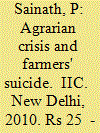

|
|
|
|
|
| Publication |
IIC, New Delhi, 2010.
|
| Description |
18p.
|
|
|
|
|
|
|
|
|
|
|
|
Copies: C:1/I:0,R:0,Q:0
Circulation
| Accession# | Call# | Current Location | Status | Policy | Location |
| 055466 | 630.92/SAI 055466 | Main | On Shelf | General | |
|
|
|
|
| 2 |
ID:
096524


|
|
|
| 3 |
ID:
046974


|
|
|
|
|
| Publication |
London, John Murray, 2001.
|
| Description |
xi, 273p.
|
| Standard Number |
0719559898
|
|
|
|
|
|
|
|
|
|
|
|
Copies: C:1/I:0,R:0,Q:0
Circulation
| Accession# | Call# | Current Location | Status | Policy | Location |
| 044581 | 355.33041/MIL 044581 | Main | On Shelf | General | |
|
|
|
|
| 4 |
ID:
160094
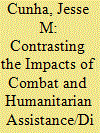

|
|
|
|
|
| Summary/Abstract |
We study the differential impacts of combat and humanitarian assistance/disaster relief (HA/DR) missions on the mental health of U.S. Marine Corps members. The deployment experiences of any individual Marine are plausibly random conditional on the observable characteristics which are used to assign Marines into units. Leveraging this exogenous variation, we compare the incidence of post-traumatic stress disorder (PTSD) and suicide deaths among Marines who deployed to either Operation Enduring Freedom/Operation Iraqi Freedom (OEF/OIF) or HA/DR missions between 2001 and 2011. We find that the hazard of PTSD is close to eight times higher among Marines returning from OEF/OIF compared to those never deployed, and just 1.33 times higher among those returning from HA/DR (and never participated in OEF/OIF). Those returning from OEF/OIF missions are 1.81 times more likely than those never deployed to die by suicide when they were still active duty, and the hazard increases to almost 3 after they have left the military. In contrast, we find no difference in the hazards of suicide death between those that deployed to only HA/DR missions and non-deployed Marines.
|
|
|
|
|
|
|
|
|
|
|
|
|
|
|
|
| 5 |
ID:
093195
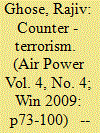

|
|
|
| 6 |
ID:
156906


|
|
|
|
|
| Summary/Abstract |
This research used open source information to investigate the motivational backgrounds of 219 suicide attackers from various regions of the world. We inquired as to whether the attackers exhibited evidence for significance quest as a motive for their actions, and whether the eradication of significance loss and/or the aspiration for significance gain systematically differed according to attackers’ demographics. It was found that the specific nature of the significance quest motive varied in accordance with attackers’ gender, age, and education. Whereas Arab-Palestinians, males, younger attackers, and more educated attackers seem to have been motivated primarily by the possibility of significance gain, women, older attackers, those with little education, and those hailing from other regions seem to have been motivated primarily by the eradication of significance loss. Analyses also suggested that the stronger an attacker’s significance quest motive, the greater the effectiveness of their attack, as measured by the number of casualties. Methodological limitations of the present study were discussed, and the possible directions for further research were indicated.
|
|
|
|
|
|
|
|
|
|
|
|
|
|
|
|
| 7 |
ID:
088775
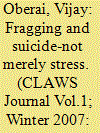

|
|
|
| 8 |
ID:
091193
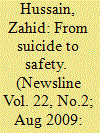

|
|
|
| 9 |
ID:
153625
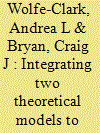

|
|
|
|
|
| Summary/Abstract |
Despite increasing prevention efforts, military suicide rates have surpassed those of the general population. This trend may reflect a deficit in our understanding of suicide, historically atheoretical and based on decreasing risk factors of suicide. The interpersonal–psychological theory of suicide (IPTS) provides a theoretical foundation to understand suicide but only assesses three risk factors of suicide and is primarily aimed at explaining who may die by suicide, but not when. The fluid vulnerability theory (FVT) provides a broad theoretical framework to understand and organize risk and protective factors of suicide in order to understand the process of suicide risk over time. Overlaying the IPTS’s constructs of thwarted belongingness, perceived burdensomeness, and the acquired capability for suicide within the FVT framework provides a robust model to understand not only who is at risk for suicide but also when suicide risk is likely to emerge.
|
|
|
|
|
|
|
|
|
|
|
|
|
|
|
|
| 10 |
ID:
193194
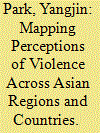

|
|
|
|
|
| Summary/Abstract |
Violence is increasing in Asia. However, limited research exists on the prevalence and types of violence across Asian regions and countries; a comprehensive study on a continental-scale in Asia has been understudied. Guided by the World Health Organization’s definition of violence, this study used World Values Survey Wave 7 (n = 35,435) to map the perceptions of the justifiability of three categories of violence (self-inflicted, interpersonal, collective) with five subtypes (suicide, intimate partner violence against wife, child abuse, violence toward other people, political violence) in six regions and 24 countries in Asia. Findings indicate that perceptions of the justifiability of violence are significantly different across regions in Asia. Perceptions of the justifiability of various types of violence differed across Asian countries. Considering the complexity and diversity of violence across Asian regions and countries, this study may be a cornerstone for violence research in Asia.
|
|
|
|
|
|
|
|
|
|
|
|
|
|
|
|
| 11 |
ID:
100131
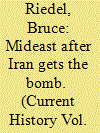

|
|
|
| 12 |
ID:
124061
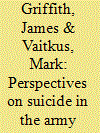

|
|
|
|
|
| Publication |
2013.
|
| Summary/Abstract |
Suicides in the US military were observed rising in 2004, most notably in the Army and Marine Corps, and particularly, in the Army National Guard (ARNG). Alarmed, Army leaders and researchers have offered various explanations and prescriptions, often lacking any evidence. In the present study, three data sets were used to examine evidence for various perspectives on suicide-dispositional risk, social cognitive, stressor-strain, and social cultural/institutional, each having different emphases on relevant explanatory variables and underlying mechanisms of suicide. Primary risk factors associated with having committed suicide among the 2007-2010 ARNG suicide cases were age (young), gender (male), and race (white), supporting the dispositional risk perspective on suicide. Some evidence supported the stressor-strain perspective in that postdeployment loss of a significant other and a major life change showed statistically significant, yet weaker associations with increased suicide intentions. Implications of results are discussed for future research and preventive strategies.
|
|
|
|
|
|
|
|
|
|
|
|
|
|
|
|
| 13 |
ID:
160290
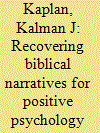

|
|
|
|
|
| Summary/Abstract |
Suicide is the ultimate outcome of a tragic and pessimistic view of life, so prevalent in ancient Greek writings. Indeed, over 16 suicides and self-mutilations can be found in the 26 surviving tragedies of Sophocles and Euripides. In contrast, only six suicides can be found in the Hebrew Scriptures. This article examines evidence regarding seven risk factors for suicide. It contrasts biblical and Greek narratives regarding each of these factors respectively: (1) Elijah against Ajax; (2) Job against Zeno; (3) David against Coriolanus; (4) Jonah against Narcissus; (5) Moses against Oedipus; (6) Rebecca against Phaedra; and finally (7) Ruth against Antigone. All these Greek narratives lead to self-destructive behaviours while biblical narratives provide a hopeful positive psychology, and a safe way out these dilemmas. It is high time to develop a biblical psychology and psychotherapy commensurate with the restored land of Israel and a Hebrew civilisation.
|
|
|
|
|
|
|
|
|
|
|
|
|
|
|
|
| 14 |
ID:
108403
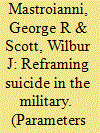

|
|
|
| 15 |
ID:
188793
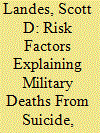

|
|
|
|
|
| Summary/Abstract |
Military suicide prevention efforts would benefit from population-based research documenting patterns in risk factors among service members who die from suicide. We use latent class analysis to analyze patterns in identified risk factors among the population of 2660 active-duty military service members that the Department of Defense Suicide Event Report (DoDSER) system indicates died by suicide between 2008 and 2017. The largest of five empirically derived latent classes was primarily characterized by the dissolution of an intimate relationship in the past year. Relationship dissolution was common in the other four latent classes, but those classes were also characterized by job, administrative, or legal problems, or mental health factors. Distinct demographic and military-status differences were apparent across the latent classes. Results point to the need to increase awareness among mental health service providers and others that suicide among military service members often involves a constellation of potentially interrelated risk factors.
|
|
|
|
|
|
|
|
|
|
|
|
|
|
|
|
| 16 |
ID:
097147


|
|
|
| 17 |
ID:
128877
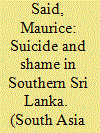

|
|
|
|
|
| Publication |
2014.
|
| Summary/Abstract |
This article shows how successful youth suicides and attempted suicides in the south of Sri Lanka are utilised as tools against an oppressive and limiting kinship structure. The majority of youth suicides in southern Sri Lanka appear to be aimed at disempowering close kin and publicly challenge the moral authority of the kin network, resulting in cleavages in the local distribution of power and status. The forms of suicide imbue the victim's family with shame, thus questioning and challenging the 'boundedness' of the family unit. Using three contrasting case studies involving a domestic argument between a young man and his spouse, a young couple from rival families, and a young woman in a post-tsunami camp, this fieldwork-based research illustrates how youth suicides bring to the fore internal tensions in the family.
|
|
|
|
|
|
|
|
|
|
|
|
|
|
|
|
| 18 |
ID:
109969
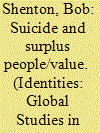

|
|
|
| 19 |
ID:
132910
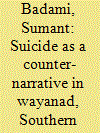

|
|
|
|
|
| Publication |
2014.
|
| Summary/Abstract |
This article demonstrates how highly-politicised assessments of agrarian distress have affected professional and public perceptions of the causes of suicide, specifically in the region of Wayanad, north-eastern Kerala. Because of a bifurcation between purely sociological and purely psychological analyses of suicide, current mental health policy downplays socio-economic factors and actively promotes specifically psychiatric analyses of victims and their families. Yet, for the sake of political representation in the public sphere, sociological analyses facilitate the construction of discursive categories relating to farmer distress.
The article shows how this has meant that the struggles of certain underprivileged groups, specifically the indigenous Paniya community, are thereby rendered invisible. Moving beyond the existing dualistic approaches, field-based research findings also demonstrate the potential to see suicide as a form of communication that provides important counter-narratives to the dominant discourse about suicides in South Asia.
|
|
|
|
|
|
|
|
|
|
|
|
|
|
|
|
| 20 |
ID:
125070
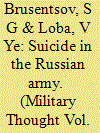

|
|
|
|
|
| Publication |
2013.
|
| Summary/Abstract |
The paper looks at the history of suicide cases in the Russian Army, their causes and ways of dealing with the problem.
|
|
|
|
|
|
|
|
|
|
|
|
|
|
|
|
|
|
|
|
|